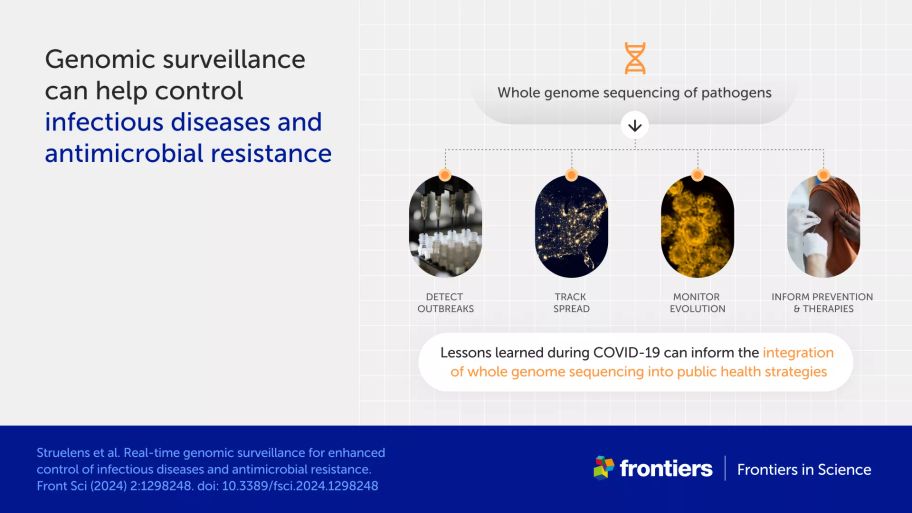Real-time genomic surveillance for enhanced control of infectious diseases and antimicrobial resistance
Explainer
Front Sci, 25 April 2024
This explainer is part of an article hub, related to lead article https://doi.org/10.3389/fsci.2024.1298248
Genomic surveillance of pathogens could help stop the next pandemic before it starts
PCR testing for COVID-19 didn’t just give us the information we needed to help protect our friends and family from infection—it also gave our societies the information we needed to help protect everyone. By sequencing the entire genetic code of SARS-CoV-2 using Whole Genome Sequencing, genetic data from the tests could be combined with epidemiological and clinical data to contribute to so-called “genomic surveillance”—a way to quickly and accurately analyze the virus, track its spread, and detect new variants. This information was, and continues to be, vital for informing public health responses, treatments, and vaccine development.
Now, in their Frontiers in Science lead article, Struelens and colleagues explain how we can achieve global, real-time genomic surveillance of other viruses, bacteria, and parasites to tackle the next big challenges of infectious disease—from pathogens in animals that could infect humans, to rising rates of resistance to antibiotics and other antimicrobial drugs.
This explainer discusses the power of genomic surveillance and the next steps for global deployment to protect the world against the next pandemic.
What is genomic surveillance?
Genomic surveillance is the monitoring and study of genetic changes and variations in disease-causing organisms like viruses and bacteria. The approach uses next-generation sequencing—now faster and more affordable than ever, thanks to advances in technology—to sequence and analyze the whole genome of a pathogen quickly and accurately.
How can genomic surveillance help control and prevent pandemics?
Genomic surveillance allows us to:
identify pathogens more accurately than by using conventional diagnostic tests
track the spread and evolution of pathogens by comparing genes and building “family trees”, based on minor differences in the genetic code of different samples
predict how dangerous a new pathogen or variant is, in terms of contagiousness, virulence, resistance to antimicrobial drugs, and/or ability to escape vaccines.
Integrated with epidemiological and clinical data, whole genome sequencing data allows us to develop a detailed real-time picture of how a pathogen works and how it can be combated. This makes it possible for us to catch emerging or drug-resistant diseases that could cause an epidemic or pandemic, understand how they spread—and take action to prevent their spread and improve patient outcomes.

What did we learn from COVID-19?
The emergency situation of COVID-19 drove the implementation of large-scale genomic surveillance, informing public health responses and decision-making as well as treatments and vaccine development.
Critical lessons learned from this pandemic include:
the importance of infrastructure and expertise that’s ready before a pandemic happens
the most effective methods of information sharing
the importance of timely, transparent, and complete data-sharing.
What new infectious disease threats can we expect?
A highly connected world has greater potential for the transmission of new infectious diseases, most of which are likely to be “zoonoses”—pathogens which have jumped from infecting animals to infecting humans. This poses a special threat when it comes to bacterial illnesses: we treat these with antibiotics in both humans and animals. Using these drugs so frequently increases the risk that bacteria will evolve so that the antibiotics no longer kill them. In addition to increasing the risk that we won’t be able to treat diseases already circulating in humans, this increases the chance that an animal disease which is already resistant to antibiotics will jump to humans. Genomic surveillance can track these risks and tackle them before they get out of control.
What is needed for genomic surveillance to protect against future pandemics?
In some places, genomic surveillance is already being successfully used. Wastewater monitoring systems used by some public health bodies allow them to pick up the signs of vaccine-preventable diseases circulating in the population and plan vaccination campaigns. Genomic surveillance is also used in some countries and at the international level to monitor foodborne diseases, pinpoint their source, and avoid mass outbreaks.
But for genomic surveillance to protect against future pandemics, we need to build coordinated, cross-border systems that fully integrate genomic, clinical, and epidemiological data. Given the widespread use of antibiotics in animals and the fact that most new infectious diseases are zoonoses, we also need to take a holistic approach to health in line with the “One Health” concept. Championed by the World Health Organization (WHO), One Health recognizes that human health is dependent on the health of an ecosystem—including the animals humans encounter, food safety, and the environment.
The authors outline key steps for global deployment of genomic surveillance systems:
upgrade whole genome sequencing infrastructure worldwide, including new sequencing technologies and analytical tools
increase technical expertise via laboratory technician and health professional training
improve collaboration between countries, public health agencies, relevant scientific disciplines, doctors, and veterinarians, taking a One Health approach
ensure interoperability and interconnectivity between genomic, clinical, and epidemiologic surveillance systems to allow real-time monitoring of pathogens
facilitate data-sharing and data access in a way that is equitable, complies with different regulatory regimes, and protects patients’ privacy.
This must happen before another novel disease appears, because we know from COVID-19 that surveillance will be most effective if it can catch new infectious diseases early.
